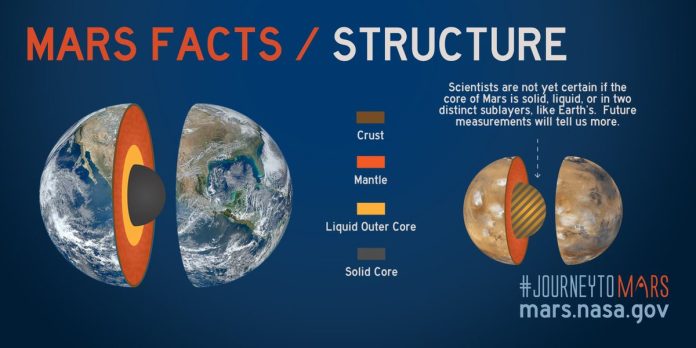A recent study has revealed the differences between the cores of the Earth and its neighbouring planet Mars.
The seismic data collected by Nasa’s InSinght lander robot show that the innermost layer of Mars — the core — is smaller and far denser than earlier believed by the scientists.
It is the best information for assessment collected to date that informs in more detail about the red planet’s core.
As both of the planets’ cores are made up of liquid iron, the Martian core is 20% mixed with other elements such as sulphur, oxygen, carbon, and a dash of hydrogen, the findings revealed.
The study was published this week in the journal Proceedings of the National Academy of Sciences.
The data shows the presence of these elements double in the Martian core meaning its core is less dense than Earth’s. However, this density is more than a 2021 estimate based on a different type of data from the now-retired InSight.
Jessica Irving seismologist at the University of Bristol in England and the lead author said: “The deepest regions of Earth and Mars have different compositions — likely a product both of the conditions and processes at work when the planets formed and of the material they are made from.”
The study also found that the size of the Martian core is a diameter of about 2,212-2,249 miles (3,560-3,620 km), approximately 12-31 miles (20-50 km) smaller than previously estimated.
Mars has a diameter of about 4,212 miles (6,779 km). Earth is 7,918 miles (12,742 km) in diameter —almost seven times larger in total volume.
The properties of the core can play a role in determining whether a planet can host life. The core is essential in generating the magnetic field of the Earth shielding the earth from harmful solar and cosmic radiations.
Irving said: “On planets and moons like Earth, there are silicate — rocky — outer layers and an iron-dominated metallic core. One of the most important ways a core can impact habitability is to generate a planetary dynamo,”.
Irving also added: “Earth’s core does this but Mars’ core does not – though it used to, billions of years ago. Mars’ core likely no longer has the energetic, turbulent motion which is needed to generate such a field.”
Seismic waves can tell much about the planet’s interior structure. The recent findings were initiated from two such events that took place on the opposite side of Mars from where the InSight lander — and specifically its seismometer device — sat on the planet’s surface.
The first occurred in August 2021 Mars quake centred close to Valles Marineris, the solar system’s largest canyon. The second was in September 2021 meteorite impact that left a crater of about 425 feet (130 meters).
InSight was formally retired by the US space agency in December after operating for four years.
The co-author of the study Vedran Lekic said: “The InSight mission has been fantastically successful in helping us decipher the structure and conditions of the planet’s interior,”
“Deploying a network of seismometers on Mars would lead to even more discoveries and help us understand the planet as a system, which we cannot do by just looking at its surface from orbit,” said Lekic who is also a geophysicist at the University of Maryland.


